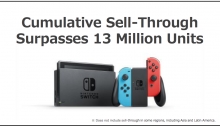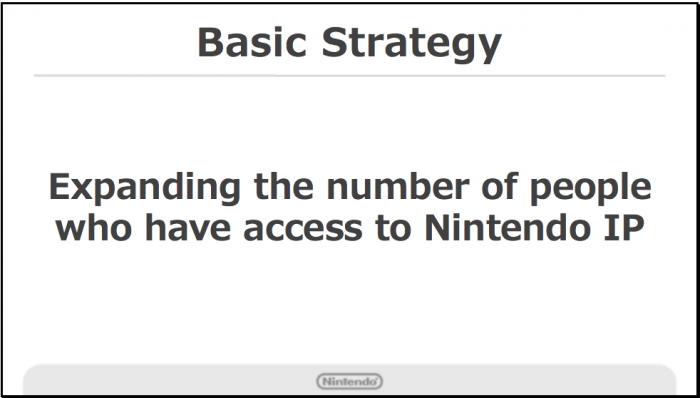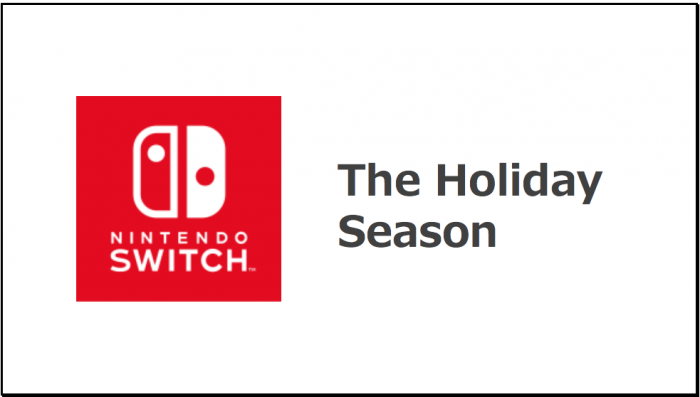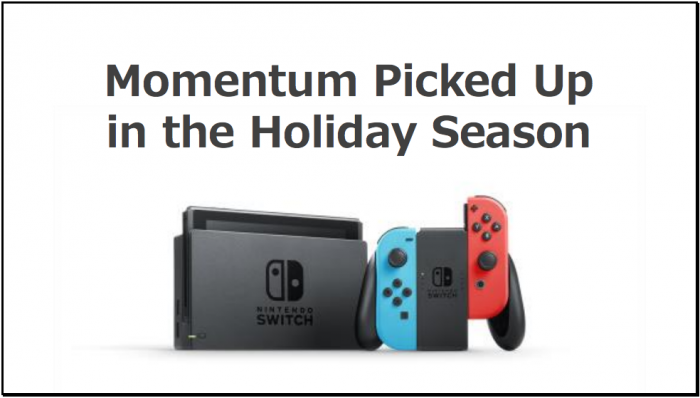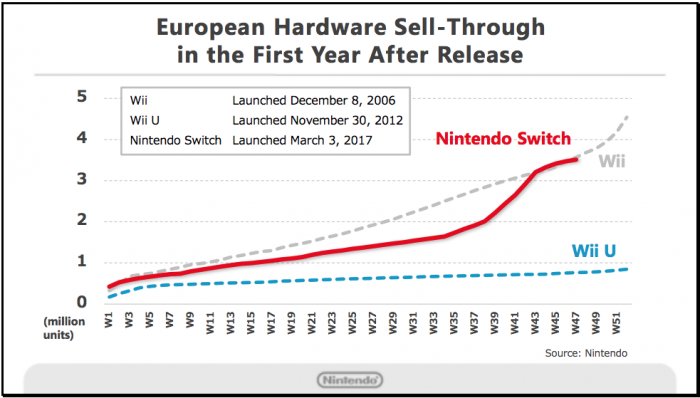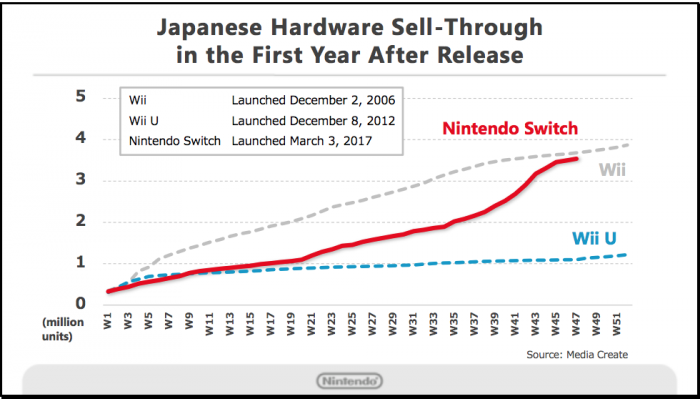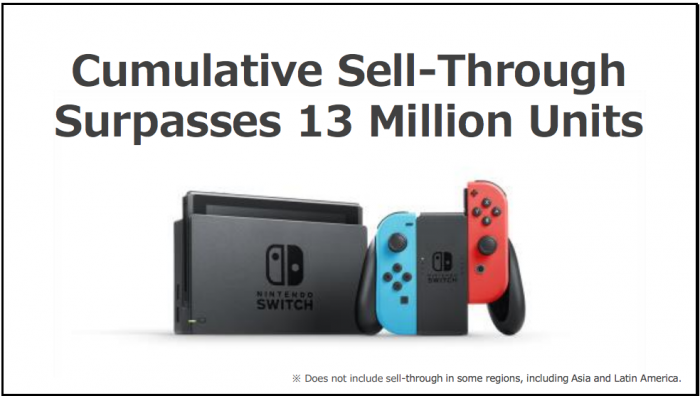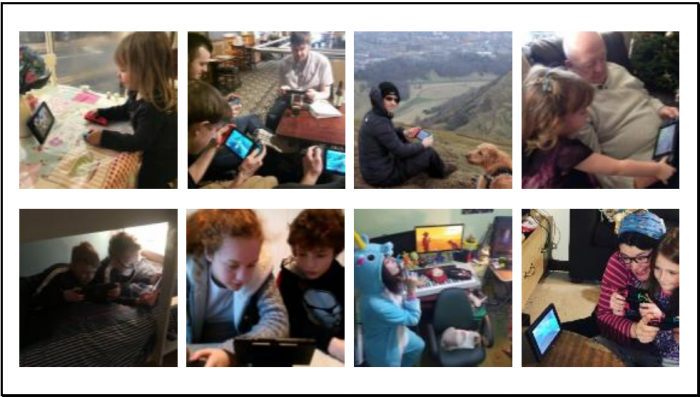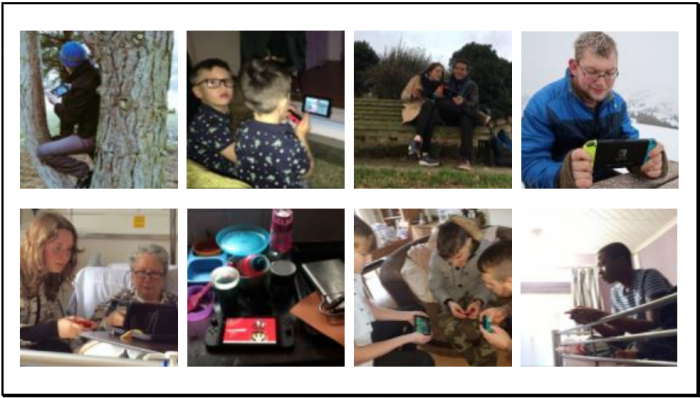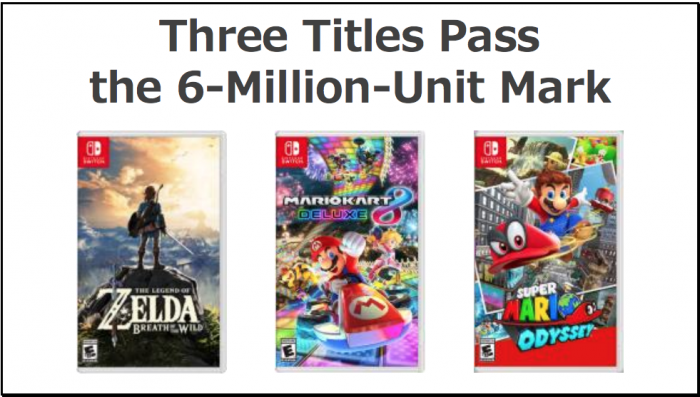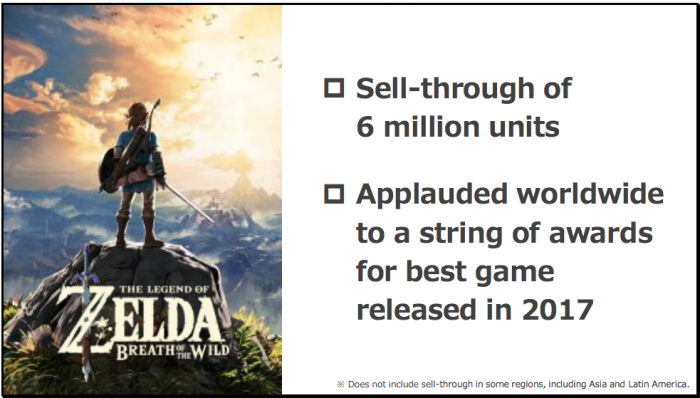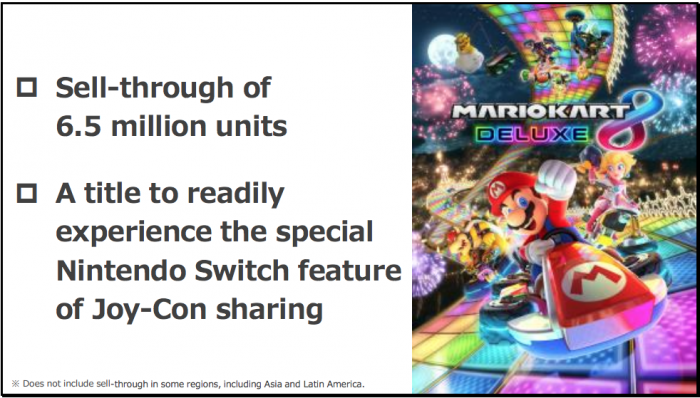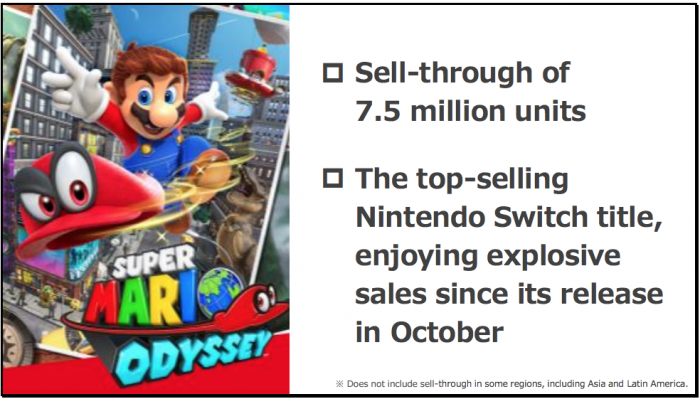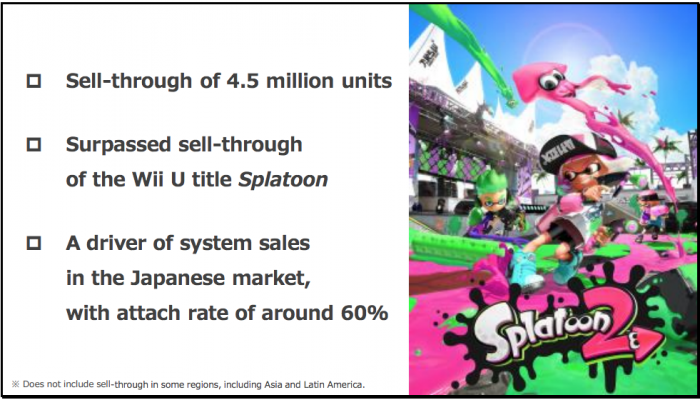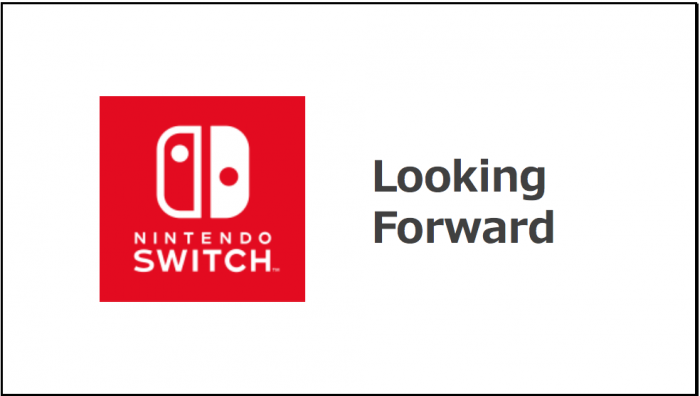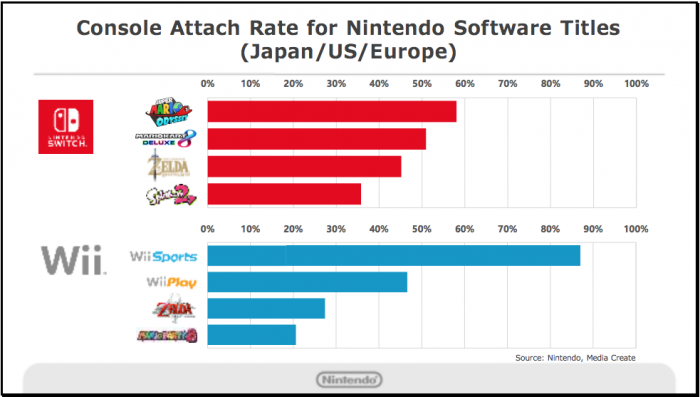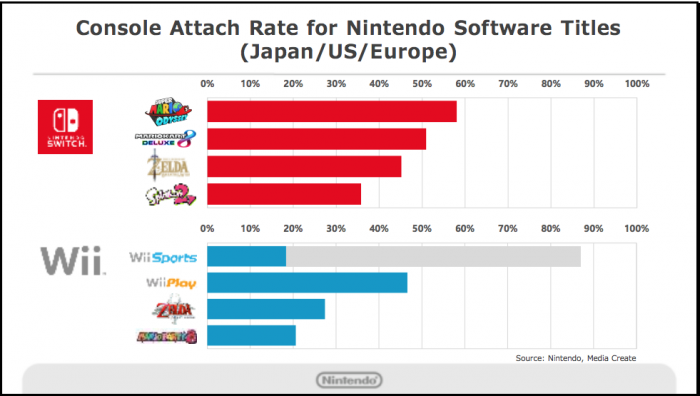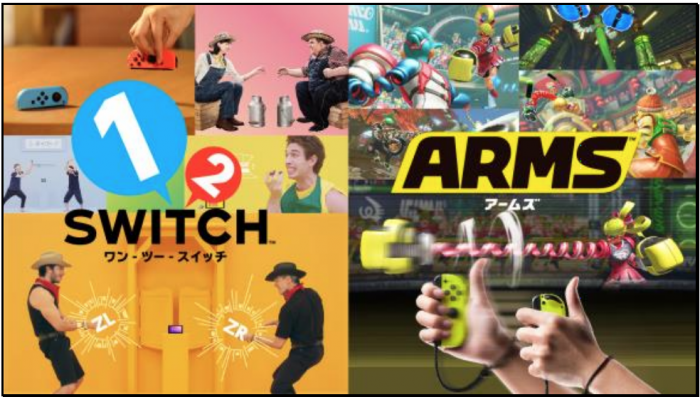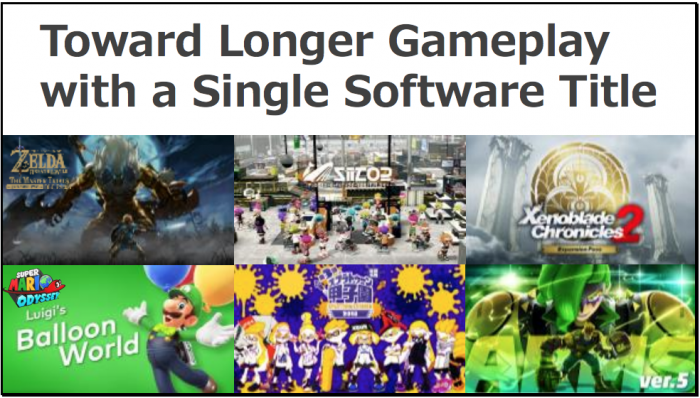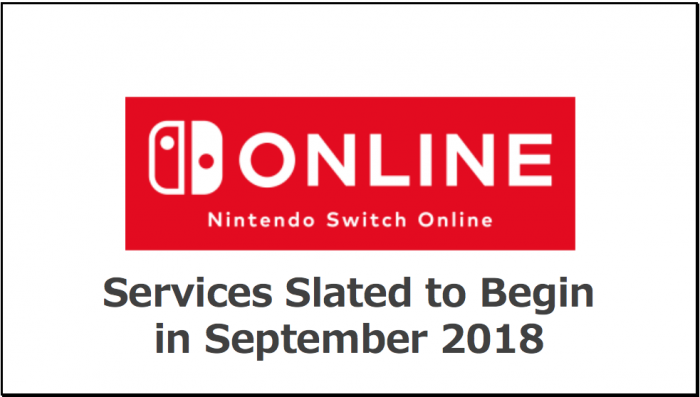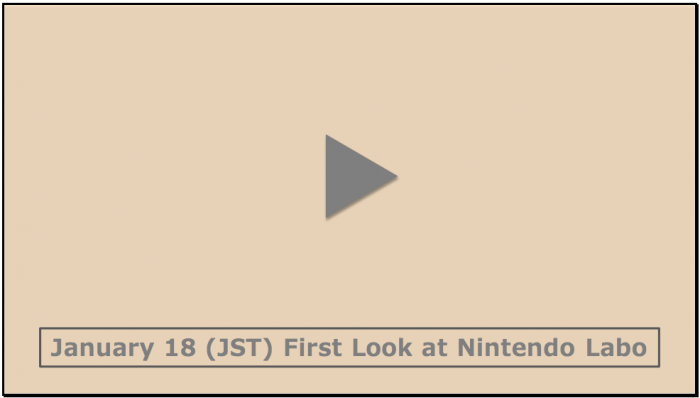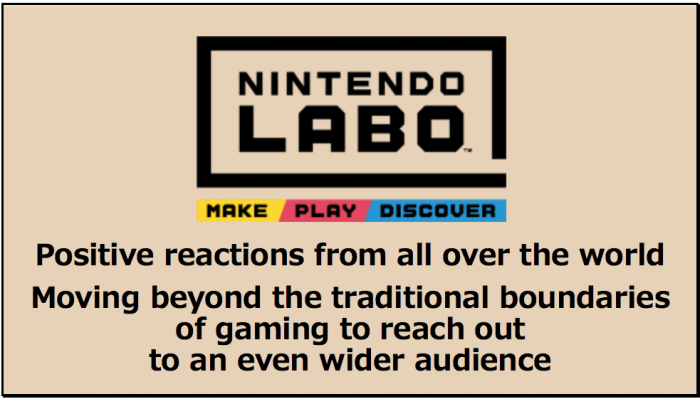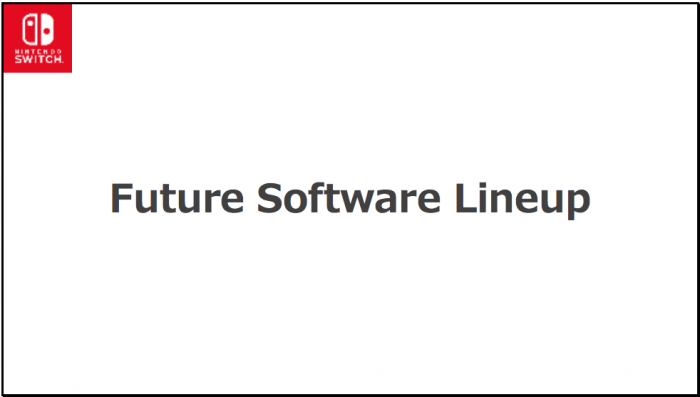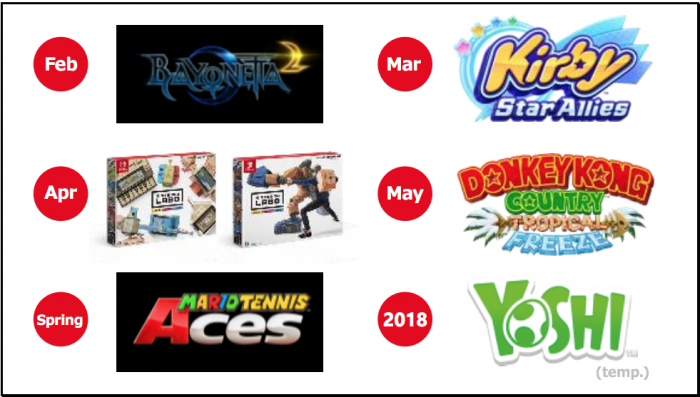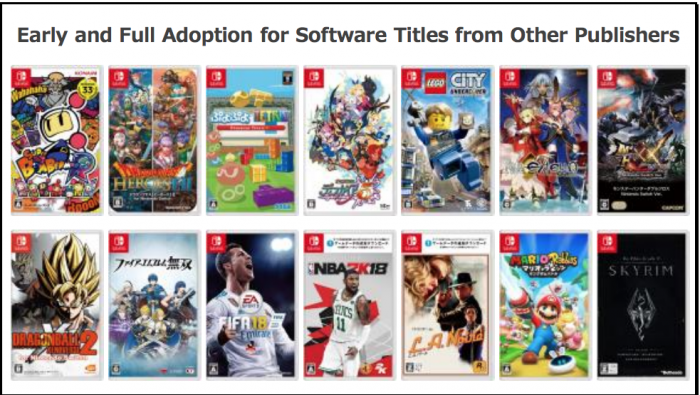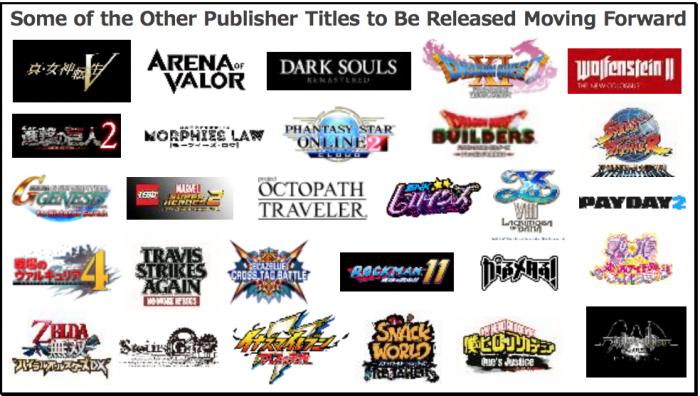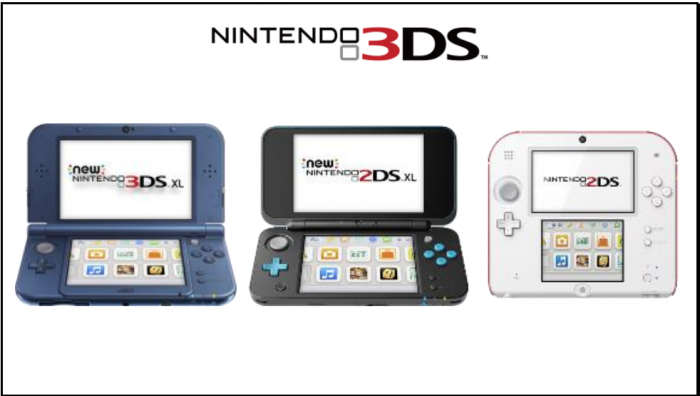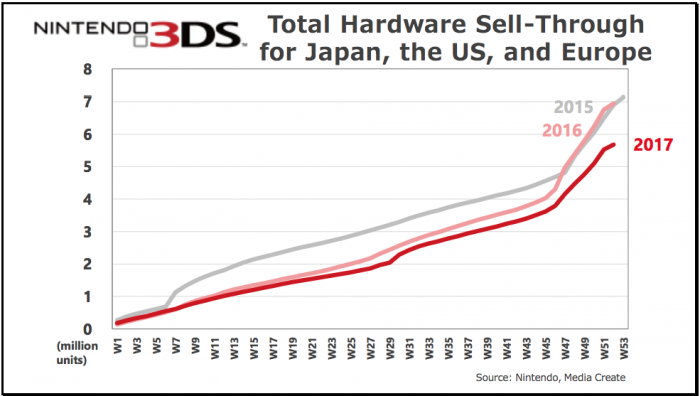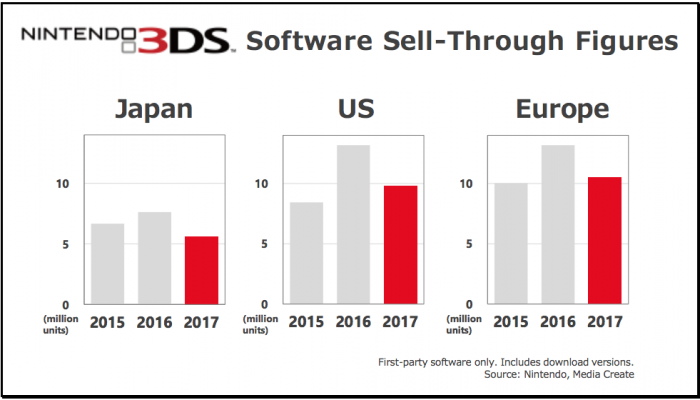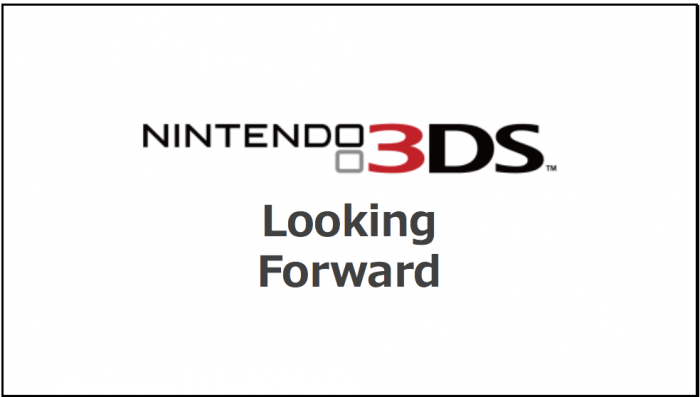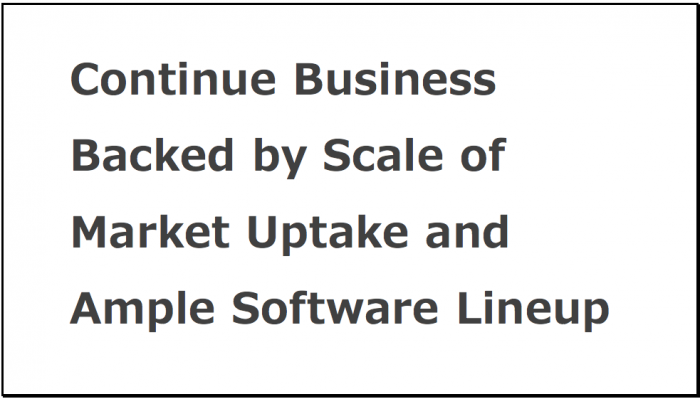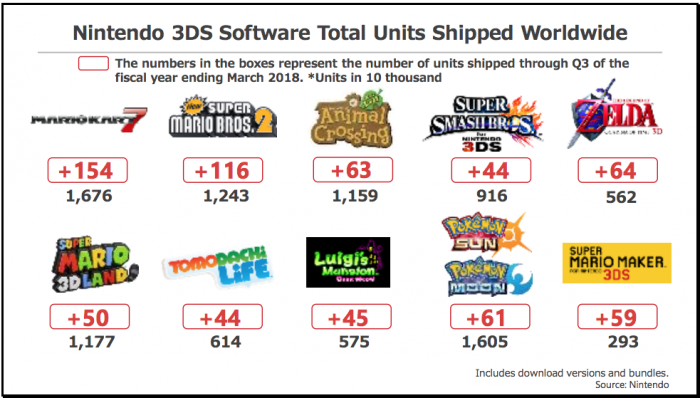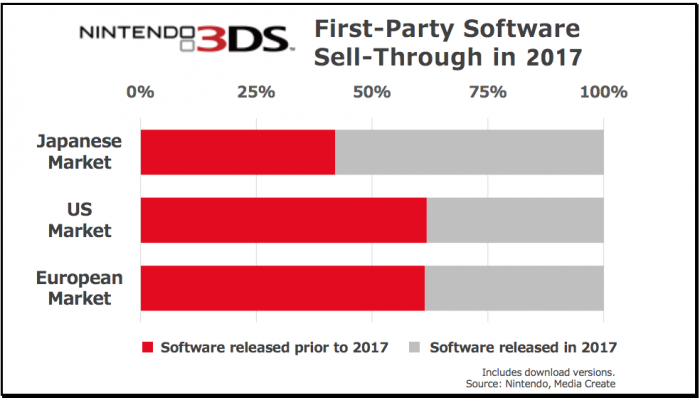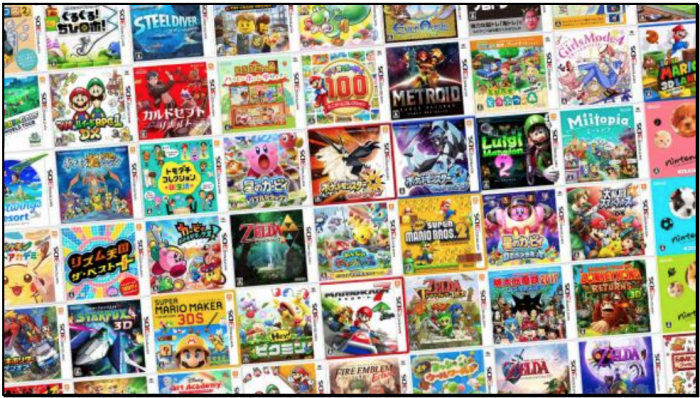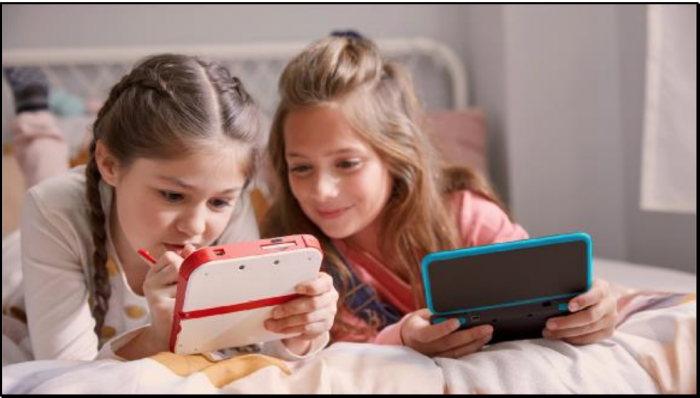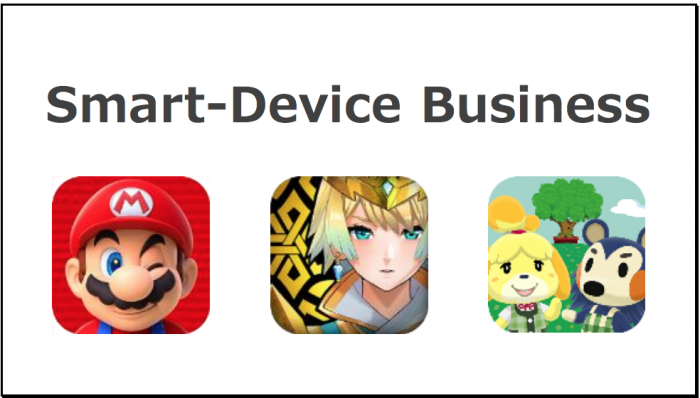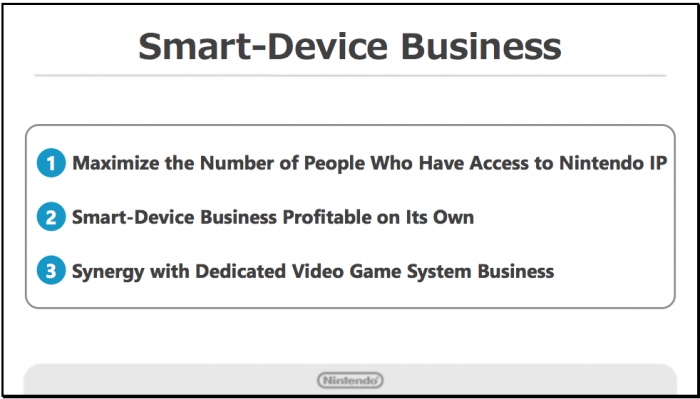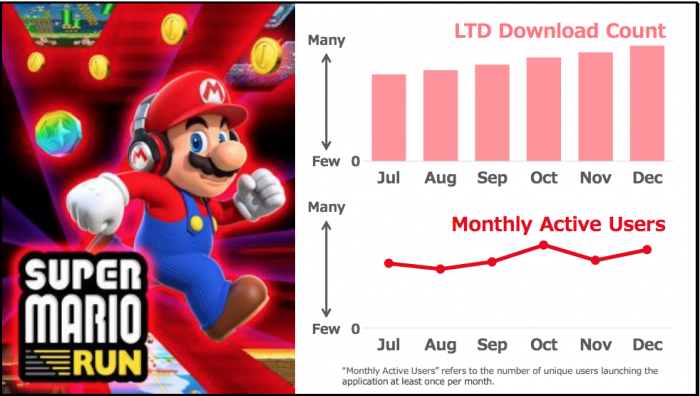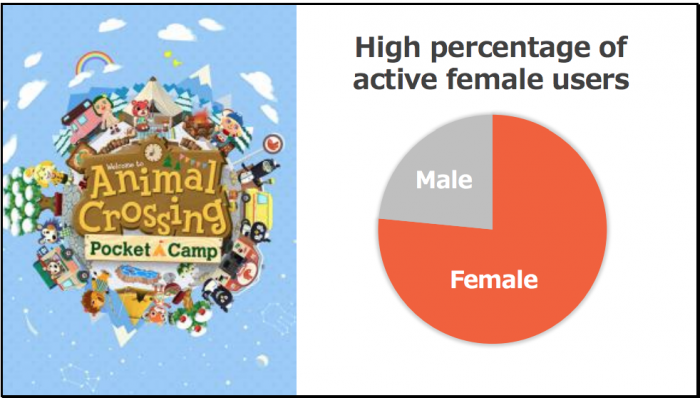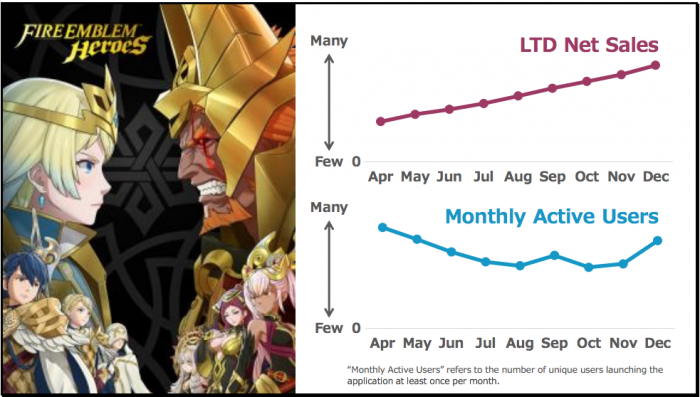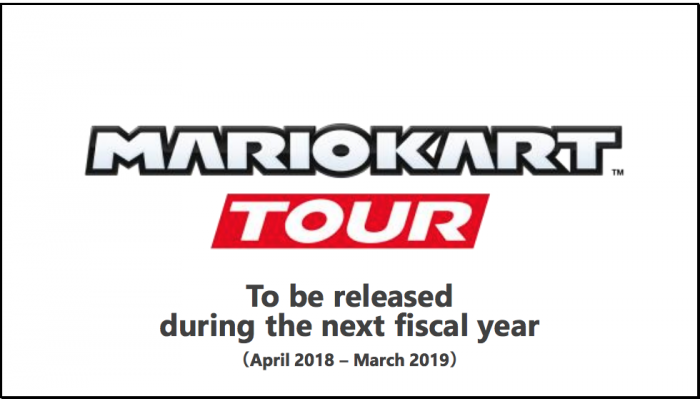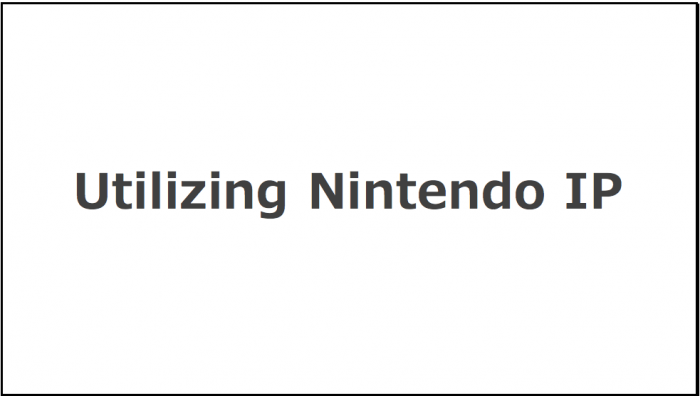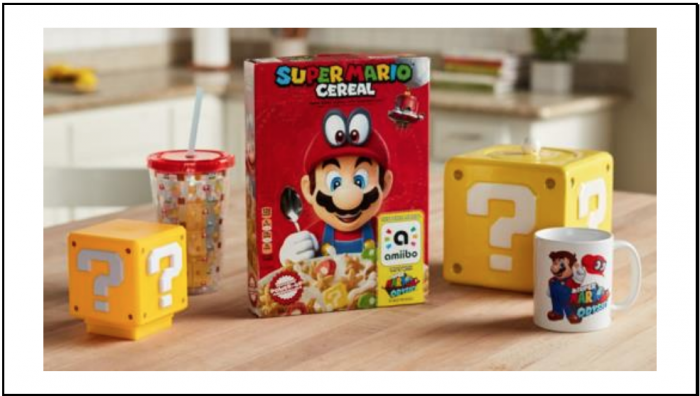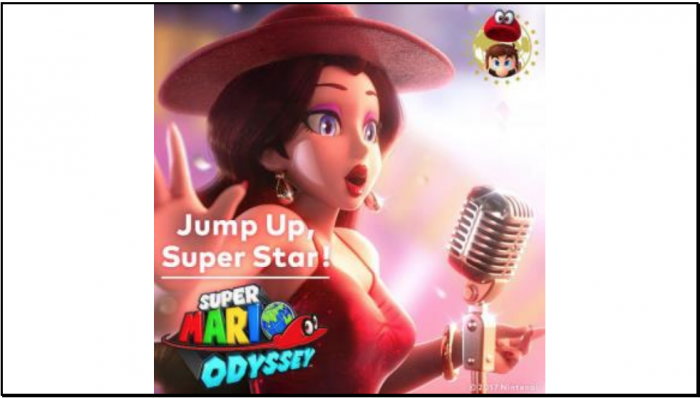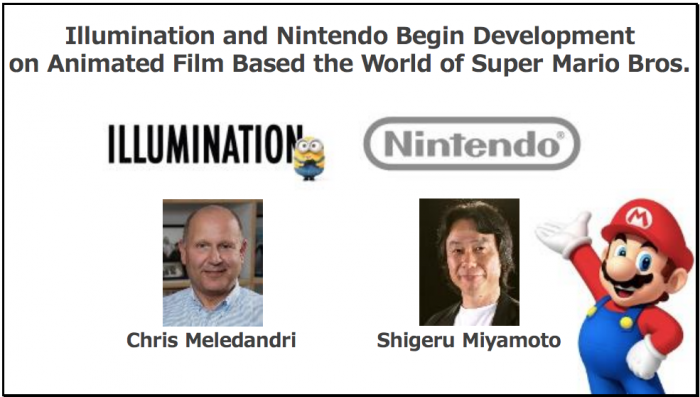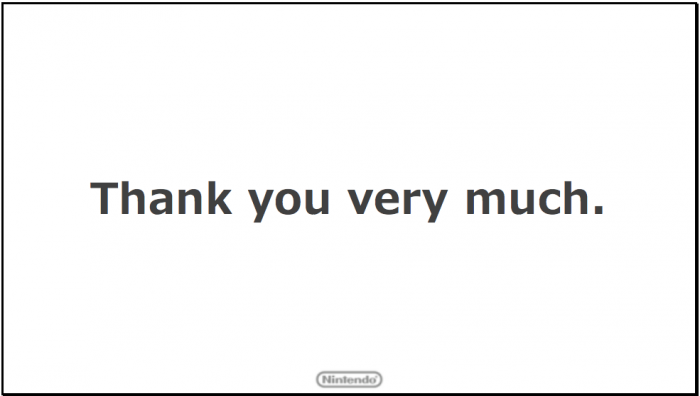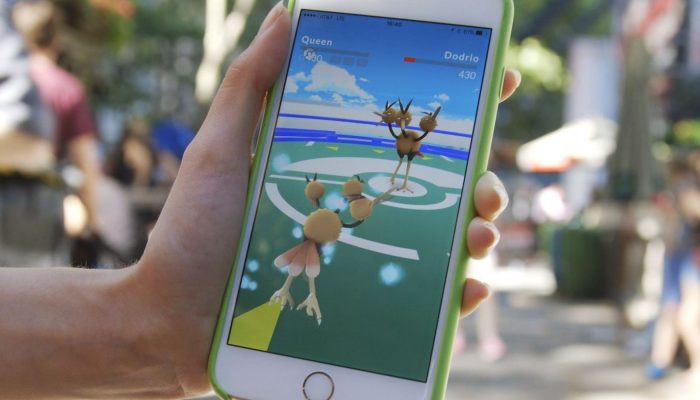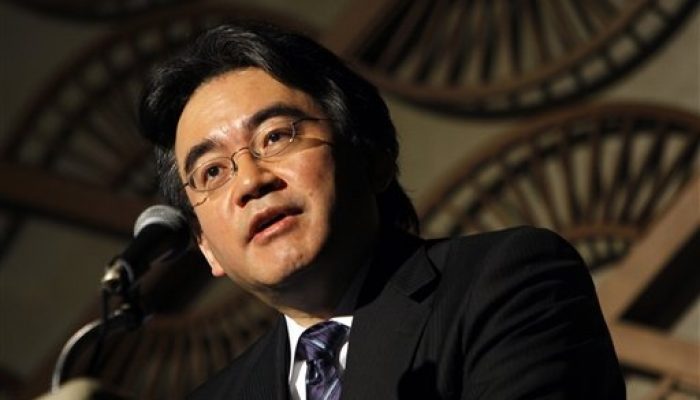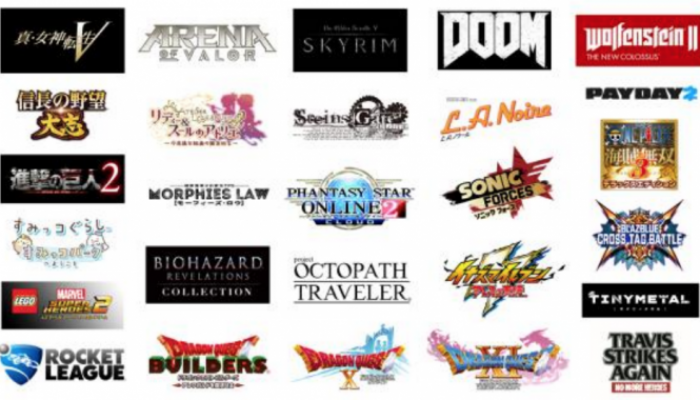 They’re actually going to make it to these 16 million Switches they were talking about at the end of this fiscal year.
They’re actually going to make it to these 16 million Switches they were talking about at the end of this fiscal year.
☆ NintendObs Event – Nintendo Q3 FY3/2018.
Thank you for making time to attend Nintendo’s corporate management policy briefing. I am Tatsumi Kimishima, President of Nintendo.
Mr. Furukawa, General Manager of the Corporate Planning Department, has just presented our financial results for this period.
Our basic strategy remains unchanged. We seek to expand the number of people who have access to Nintendo IP. Here I will describe the state of Nintendo’s business in line with this basic direction and the future outlook.
Let’s begin with the status of the Nintendo Switch business.
First let me talk about last year’s holiday season. At last year’s financial results briefing in October, I noted that the big challenge for Nintendo Switch in its first holiday season was to gain the support of a wide range of consumers. I also noted that we would expand production in order to supply the product in stable quantities for the holiday season. This was the result:
As we entered the holiday season, the installed base of Nintendo Switch hardware began expanding at an accelerated pace around the world. Let me turn now to a discussion of our primary markets.
This graph shows changes in cumulative sellthrough in the North American market following the release of Nintendo Switch. The sell-through figures for Wii and Wii U in their first years after launch are superimposed on the graph. Keep in mind that Wii and Wii U were released during the holiday season, whereas Nintendo Switch was released in March, meaning that the timing of the release differed from the timing of the holiday season. As you can see, the pace of Nintendo Switch sales, depicted by the red line, picked up substantially during the holiday season. Because the Nintendo Switch launch was not timed to the holiday season, you cannot make a simple comparison between platforms. However, Nintendo Switch is establishing itself at a record pace, with the first 10 months of sales in North America exceeding even those for Wii, which had been our previous fastest-selling home console.
These are the figures for the European market. In the European market, Nintendo Switch sales grew substantially during the holiday season, exhibiting a momentum comparable with Wii.
These are the figures for the Japanese domestic market. In the domestic market in Japan, we were able to deliver strong supply for the holiday season, and sales increased dramatically.
Nintendo Switch was released in March of last year and surpassed the cumulative global sell-through milestone of 10 million units in early December. The number now exceeds 13 million. The results for the first holiday season exceeded our expectations.
Nintendo Switch is a video game system that offers a new kind of experience, summarized by the concept of a system that can be played anytime, anywhere, and with anyone. It is a home gaming system that can be taken out on the go. By sharing the Joy-Con controllers, you can begin to play a game immediately at any time with anyone, anywhere.
In Europe, a campaign was launched last year to encourage people to post images on Twitter about their play with Nintendo Switch using the hashtag #OnlyOnSwitch. The pictures you are viewing are from that promotion. We see consumers enjoying Nintendo Switch in places and in ways unimaginable before, to fit different styles of play.
This supports the notion that behind the sales momentum is the fact that the Nintendo Switch hardware is unlike any video game system to date, with unique features appreciated by people around the world.
Next let’s talk about software. In the first year of Nintendo Switch, sell-through has already exceeded 6 million units for three separate game titles, and their sales continue to grow.
Sell-through for The Legend of Zelda: Breath of the Wild, released in March of last year, has reached 6 million units for the Nintendo Switch version alone, and 7.5 million units total when you include the Wii U version, released at the same time. The game has received accolades from game media and consumers around the world and has won a variety of awards as the best game of 2017.
Mario Kart 8 Deluxe, released in April of last year, has achieved a sell-through of more than 6.5 million units. This title is an easy way to give users the opportunity to experience Joy-Con sharing, which is one of the special features of Nintendo Switch. You can see from the postings on social media how fun it is for people to get together and share the controllers to play Mario Kart 8 Deluxe.
Super Mario Odyssey, released in October of last year, has achieved a sell-through of more than 7.5 million units. This title has enjoyed explosive growth in sales alongside the Nintendo Switch system since its release, and is currently the top-selling software title for Nintendo Switch.
In addition, there is Splatoon 2, released in July of last year, whose sell-through numbers have grown past 4.5 million units to already exceed the sellthrough for its predecessor, Splatoon for Wii U. This title has served to drive sales of the Nintendo Switch hardware particularly in the Japanese market, where it has an attach rate of approximately 60% for all system sales.
Note: The console attach rate is calculated by dividing the total software sell-through by the total hardware sell-through.
Let’s turn to the future prospects for the Nintendo Switch business.
Nintendo Switch is now in a phase of expanding adoption, and our business focus moving forward must consider approaches for both those who have already purchased Nintendo Switch and those considering a purchase.
A primary objective will be to maintain the interest of consumers who have already purchased Nintendo Switch to encourage their continued gameplay. And to further expand our base, it will be critical to see a wider range of consumers purchase Nintendo Switch.
We were able to offer multiple hit titles early on for Nintendo Switch that serve as powerful drivers for hardware sales. These kinds of titles can broaden the user base for the hardware and help sustain hardware sales. I mentioned the sales numbers for these different titles, but the release of multiple hit titles at the time of the launch of new hardware has significance beyond the mere fact that certain numbers of units were sold for individual titles.
Take a look at this graph. It charts the console attach rates for the top four Nintendo software titles for Nintendo Switch. For comparison, there is a graph for sales after the same amount of time had elapsed for Wii. Wii Sports was an explosive trigger for Wii sales. Wii Sports was bundled with the Wii console in the North American and European markets.
Graying out the bundled portion of Wii Sports sales yields the results shown. The blue remainder represents the ratio of stand-alone Wii Sports software sales to total hardware sales in Japan, the US, and Europe.
As you can see, there were multiple Nintendo software titles available early on for Nintendo Switch, with high attach rates. The expectation is that these software titles will drive hardware sales over the long term and will have long sales lives themselves as the hardware continues to sell. The presence of multiple popular titles for a game machine influences the purchasing decisions of people considering Nintendo Switch. And consumers who have already bought Nintendo Switch look at these popular titles as candidates for their second and third software purchases. This current state serves as a powerful booster for our hopes of further growth in Nintendo Switch sales in the medium term.
We have other Nintendo software titles already for sale that demonstrate the uniqueness of Nintendo Switch gameplay. During the year-end holiday season, people worldwide had fun playing 1-2- Switch even if they were not players of regular video games. ARMS, a fighting game using a Joy-Con controller in each hand, is so intuitive to operate the even kids can play, but deep enough to satisfy even experienced gamers. Our aim is to offer more software options to spark interest in Nintendo Switch among consumers considering a purchase.
To promote longer gameplay for individual software titles, we plan to implement even more downloadable content and events that build excitement for games.
Next let’s talk about Nintendo Switch Online, the paid subscription service that expands the online functionality of the Nintendo Switch. We reported previously that the service would launch in 2018, and now the official start time has been set to September 2018. Work is progressing on ways to further heighten the gaming experience for consumers. Details will be made available as they are finalized.
Looking ahead at the next stage for Nintendo and Nintendo Switch, we believe we need to offer very Nintendo-like “new forms of play.” One of those efforts is Nintendo Labo, which we announced just the other day.
(Refer to the presentation materials (First Look at Nintendo Labo, January 18, 2018 (JST)))
Consumers around the world who watched this video had generally favorable responses, including some who voiced delighted surprise that Nintendo had once again done the unexpected.
The release is set for April, so this was just a teaser to unveil the product. We will introduce the full particulars for Nintendo Labo over the course of the weeks ahead through hands-on events and a variety of promotional activities by Nintendo.
The response by families to the Nintendo Labo Studio hands-on events has been tremendous. In just the four days following the release of the Nintendo Labo video, applications outstripped spaces 50 fold in the US. The ratio of applications to spaces was extremely high in other markets as well. We are very thankful for this response from families around the world. We are also looking forward to directly experiencing the responses of consumers to the hands-on events.
Nintendo Labo is a product intended to broaden the possibilities of Nintendo Switch. We hope to develop Nintendo Labo into a product that is not bound by the conventional boundaries of video games, and that endears itself to an even broader range of consumers.
New software titles will be released for Nintendo Switch to satisfy everyone, from our game fans to family gamers.
As shown, from February onward we will be releasing a wide variety of new software titles one after the next.
More than 300 software titles are already available for Nintendo Switch from other software publishers. Early participation of many publishers has led to the release of software titles in a wide variety of genres.
In addition to the packaged titles available in stores, many unique download-only titles have been released in Nintendo eShop, providing consumers with an even wider selection of software titles.
We believe that the availability of software titles will continue to accelerate as a result of the widespread acceptance of Nintendo Switch by other software publishers. In addition to the software titles you see here, a string of titles in a wide variety of genres will be released in the future.
Next, I will discuss the status of Nintendo 3DS.
This graph shows changes in Nintendo 3DS hardware sell-through, as a total for the Japanese, US, and European markets combined. Although sales are trending lower than last year, the results from our seventh holiday season sales have maintained stable levels. As explained during the financial results briefing in October of last year, the Nintendo 3DS family of hardware has continued to sell steadily without significant fall-off, even after the release of Nintendo Switch.
This graph shows Nintendo 3DS software sellthrough figures for 2017 compared against the two previous years. Overall totals for 2017 were down compared to 2016 when Pokémon Sun and Pokémon Moon had globally intense sales levels, but exceeded 2015 in the US and European markets.
Let’s turn to the future prospects for the Nintendo 3DS family business.
The Nintendo 3DS characteristics, price points, and play styles differ from Nintendo Switch, and we intend to continue the Nintendo 3DS business separately and in parallel. We will continue to use its installed base and rich software library in our business.
These figures represent the total number of units shipped worldwide for key Nintendo 3DS titles. The numbers in the red boxes represent the number of units shipped during the fiscal year ending March 2018 alone. Shipment volume has increased this year even for several titles that were released some time ago.
Note: The number of units shipped for Animal Crossing: New Leaf includes units sold as Animal Crossing: New Leaf – Welcome amiibo.
This graph shows the percentage of 2017 first-party software sell-through comprised by software released in or before 2016, broken out by region. It will give you a sense of how robust our current software lineup is.
A multitude of titles across a wide variety of genres have been released for Nintendo 3DS, creating one of the strongest lineups ever. We are, of course, continuing to develop new software, but we believe it is important to leverage the rich library of Nintendo 3DS series titles to drive sales with Nintendo 3DS owners, as well as consumers who recently purchased Nintendo 3DS hardware.
The affordability of the Nintendo 3DS family of systems places it in a critical position as the first dedicated video game platform for children who have no prior experience with dedicated video game systems. It is also positioned as an affordable product for budget-conscious consumers. We will continue working to promote Nintendo 3DS to these consumers.
Next we will discuss Nintendo Classic Editions.
During fall of last year, we brought back the nostalgic Super Nintendo Entertainment System as a palm-sized home console. Super Nintendo Entertainment System: Super NES Classic Edition has reached 4 million units in global sell-through.
Note: This hardware is called the Nintendo Classic Mini: Super Famicom in Japan and the Nintendo Classic Mini: Super Nintendo Entertainment System in Europe and Australia.
We have announced that we will resume production for NES Classic Edition this year. We plan to continue selling NES Classic Edition and Super NES Classic Edition this year. We view them as an opportunity to garner interest in Nintendo Switch from those who have not interacted with video games in a long time, or ever.
Note: Nintendo Classic Mini: Family Computer is called Nintendo Entertainment System: NES Classic Edition in the US, and Nintendo Classic Mini: Nintendo Entertainment System in Europe and Australia.
I will now talk about our smart-device business.
We have three main goals when it comes to our smart-device business. We aim to utilize smart devices as a platform to reach the maximum number of consumers with our IP. We also hope to grow the smart-device business into a pillar of revenue for Nintendo. Furthermore, we aim to generate synergy with our dedicated video game systems to maximize the potential of our overall business strategies. Just as Super Mario Run particularly contributes to expanding the reach of Nintendo IP, each application has different characteristics and goals with respect to these overall business aims. Rather than achieving each of these aims with a single application, we are striving to use multiple applications to achieve these goals for the business as a whole.
In September of last year, Super Mario Run received a major update, version 3.0. At the financial results briefing in October of last year, we reported that Super Mario Run had achieved 200 million total downloads, and the number of downloads has continued to increase since then. We are maintaining a base of approximately 20 million monthly active users. This game helps to maximize the number of people who have access to Nintendo IP by providing a Mario game that a wide variety of users around the world can enjoy.
Animal Crossing: Pocket Camp was released in October of last year, and female players make up a high percentage of the user base, with the majority of these female users being adults. This title sparked interest among many female consumers to pick up this smart-device application. Through continuous updates to add game content and hold weekly events, we aim to create a service that consumers can play daily, and that simultaneously contributes financially.
In November of last year, Fire Emblem Heroes received a major update, version 2.0, enabling us to maintain and grow the number of active users. We are also seeing continuous growth in terms of net sales. Tomorrow, February 2, is the one-year anniversary of the application’s release. We are working on a variety of future initiatives for users to enjoy, including a special campaign celebrating the application’s anniversary. We are also planning TV commercials.
As you can see, we will continue to provide ongoing support for our existing smart-device applications. In addition, new smart-device applications are under development.
We plan to release a smart-device application from the Mario Kart franchise, Mario Kart Tour, during the next financial year (from April 2018 to March 2019). We will announce further details at a later date.
Finally, I will speak about utilizing Nintendo IP.
As part of utilizing Nintendo IP, we hope to increase visibility of Nintendo characters in the daily lives of our consumers and boost familiarity with the worlds in games made by Nintendo as entertainment. By combining the effects of many such initiatives, we aim to create an engine of competitiveness in the dedicated video game platform business and all of our other businesses.
I will introduce several examples from 2017. The winners of the UTGP T-shirt design competition held in cooperation with Uniqlo were announced, and their designs were sold in Uniqlo stores worldwide.
Kellogg released a breakfast cereal in the US that features Mario on the box. The box contains a new initiative, an amiibo tag with an NFC chip.
Last year we also piloted the release of the main theme songs from game software on music distribution services, ahead of the release of the game software itself.
In addition to these examples, we are engaging in other initiatives to boost opportunities for consumers to interact with Nintendo characters by increasing the number and variety of regional and worldwide collaborations with partner companies. In this way, we will continue seeking to raise the value of Nintendo IP and maximize the potential of our overall business strategies.
Lastly, we will now introduce a new initiative to effectively use Nintendo IP. We have started development of an animated movie featuring “Super Mario” with Illumination, the movie studio that brought films such as “Despicable Me” and “Minions.” For this project Mr. Chris Meledandri, Founder and CEO of Illumination and Shigeru Miyamoto, Representative Director, Fellow of Nintendo will co-producing the film. The film will be co-financed by Universal Pictures and Nintendo, and distributed theatrically worldwide by Universal Pictures.
Further announcements on details such as release dates will be made at a later date. We look forward to providing further information about the release timing for this movie that we hope everyone will enjoy.
As a part of our effort to expand Nintendo IP beyond video games, we look forward to bringing smiles to people around the world through this movie.
This concludes our presentation.
Thank you very much.
— Tatsumi Kimishima, President of Nintendo
Source: Nintendo JP.
At NintendObserver, the comments are on Discord.
Click on Community to learn more. 🙂
…
…Wanna play? Buy a Switch.
And if you’ve already got yours, here are all the games already available on the platform. 😀
